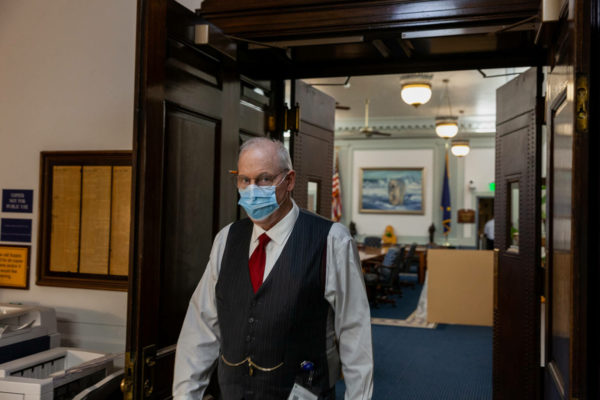
The Legislature must decide this year whether to engage in unplanned spending from the Alaska Permanent Fund for the first time. Some lawmakers are raising concerns that once the state starts unplanned spending of billions of dollars, it won’t stop until there are no fund earnings left.
The Legislature faces a familiar problem. For the seventh straight year, since oil price plummeted, Alaska’s state government is spending more than it’s taking in.
But there’s a new issue. There isn’t enough left in the piggy bank the state has used for decades to cover deficits — the Constitutional Budget Reserve — to manage the state’s cashflow and to pay even $1,000 Permanent Fund dividends like Alaskans received last year.
Some — most prominently, Gov. Mike Dunleavy — have called for spending much more from the Permanent Fund than the state planned. He wants the state to follow the formula in a 1982 state law to pay out nearly $5,000 in Permanent Fund dividends. That amount would cover this year’s dividend, plus the amount that wasn’t paid out last year under the traditional formula.
Dunleavy explained why in a short video posted on social media late last year.
“I couldn’t think of a better time to follow the PFD law,” he said. “I can’t think of a better time for Alaskans to get $5,000. This pandemic has done a lot of damage in Alaska, across this country, across this world.”
The Republican governor has proposed drawing the money from Permanent Fund earnings, the traditional source for PFDs. That means this year, the state would take $6.3 billion this year out of the $14.9 billion in the earnings reserve as of Jan. 31.
That’s much more than allowed by a law passed three years ago, intended to limit draws to roughly 5 percent of total fund. That level of withdrawal is projected to be small enough to allow the fund to keep growing: The bulk of the fund — $57.8 billion — is locked away in unspendable principal.
As the CEO of the Alaska Permanent Fund Corporation, Angela Rodell is responsible for overseeing how the fund is invested. She noted the corporation’s board supported the 5 percent draw, based on what’s known as the percent of market value, or POMV. If the state spends beyond what the law says it should this year, she’s concerned it won’t stop.
“And so, yes, I do worry that if we don’t follow a POMV spending rule, it will open floodgates,” she said.
Rodell noted the annual draw to the state is now paying for the majority of state spending that the legislature controls. She added there could be short-term benefits from increasing state spending to help the economy.
“And, yet, I wonder, what are we creating for ourselves in three, four, five years, in 10 years?” she asked in a recent House Finance Committee meeting. “Do we have a place for your 2-year-old or your 5-year-old to grow up in? So we really have to ask ourselves: What do we want Alaska to be?”
Dunleavy has said another reason for spending more this year is the Permanent Fund has grown a lot — more than $7 billion from June to January. But Permanent Fund trustees and legislators who passed the law limiting draws have said annual spending from the fund shouldn’t go up and down with the market. By maintaining a predictable draw, fund managers can focus their investing decisions on growing the fund, without worrying about losing large amounts in a bad market.
Sitka Republican Sen. Bert Stedman wants the Legislature to make changes this year to bring the budget into balance over the next two or three years. Without changes, he sees a scenario where the state will have high taxes in the future and no dividends.
“Do you want to have two or three good years of big dividends, and then no dividends for your grandkids? I think not,” he said. “You know, this generation has been very, very fortunate. We’ve rode through the oil boom for the last 40 years, reaped enormous amounts of wealth and benefits. Let’s leave some of it for our kids.”
Stedman said spending down the Permanent Fund’s earnings would force the fund to take fewer investment risks, which would limit its growth and hurt it in the long run.
“They won’t know what the Legislature is going to do in any given year,” he said of fund managers. “Therefore, they’re forced into a very liquid position. It is a foolish, foolish thing to do.”
Stedman is concerned that once the Legislature starts spending more than planned, it won’t stop until there’s nothing left in fund earnings. Under that scenario, lawmakers could then consider amending the state constitution to spend from the Permanent Fund’s constitutionally protected principal, he said.
“Once the Legislature basically kicks the door in … it’s going to be a lot easier the following year,” he said. “And then within a couple of years, they won’t even think about it.”
There is one factor that could make the budget less painful this year: The amount the state is receiving from the federal government in pandemic relief.
The Senate Finance Committee will be examining the size of the state’s annual future deficits in upcoming hearings. Dunleavy’s administration has estimated their size as roughly $1 billion. But, without major changes, budget experts have said the amount would be closer to $2 billion.
Andrew Kitchenman is the state government and politics reporter for Alaska Public Media and KTOO in Juneau. Reach him at akitchenman@alaskapublic.org.




